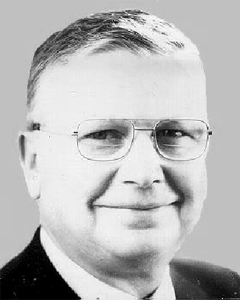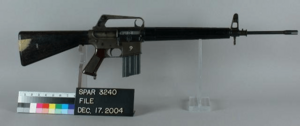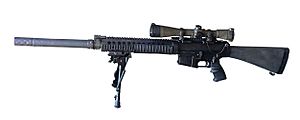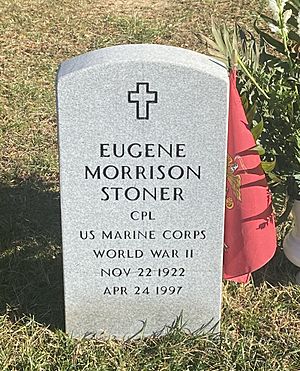Eugene Stoner facts for kids
Quick facts for kids
Eugene Stoner
|
|
|---|---|
 |
|
| Born | November 22, 1922 Gosport, Indiana, U.S.
|
| Died | April 24, 1997 (aged 74) Palm City, Florida, U.S.
|
| Resting place | Quantico National Cemetery |
| Occupation | Engineer |
| Engineering career | |
| Significant design | AR-15 and other small arms |
Eugene Morrison Stoner (born November 22, 1922 – died April 24, 1997) was an American machinist and a very important firearms designer. He is best known for creating the ArmaLite AR-15 rifle. This rifle was later changed and used by the United States military as the famous M16 rifle.
Contents
Early Life and Military Service
Eugene Stoner was born in Gosport, Indiana. His family later moved to Long Beach, California, where he finished high school. After the Great Depression in 1939, it was hard for many families to afford college. So, Eugene started working as a machinist for an aircraft company.
During World War II, he joined the U.S. Marine Corps. He served in the South Pacific and in northern China. In the Marines, he worked with large automatic weapons as an armourer. This experience helped him a lot in his future career of designing weapons.
Becoming an Engineer and Designer
After World War II, in late 1945, Stoner began working for Whittaker, a company that made aircraft equipment. He eventually became a Design Engineer there.
In 1954, he joined ArmaLite, which was part of Fairchild Engine & Airplane Corporation. As the chief engineer at ArmaLite, he designed many different prototype (test) small arms. Most of these, like the AR-3, AR-9, AR-11, and AR-12, were not produced in large numbers. However, one of his early successes was the AR-5 survival rifle, which the United States Air Force used.
How Stoner's Rifles Worked
Eugene Stoner developed a special way for his rifles to work, using gas from the fired bullet to reload the gun. This system is often called a "direct impingement" system, but Stoner himself said it was a "true expanding gas system."
Here's a simple way to think about it:
- When a bullet is fired, hot gas goes from the barrel through a small tube.
- This gas goes directly into a part called the bolt carrier.
- Inside, the gas pushes the bolt and carrier like a piston in an engine.
- This pushing motion makes the gun reload itself.
This design made the rifle very balanced and allowed the parts to move in a straight line. This meant the gun had less "kick" (recoil) when fired, making it easier to shoot accurately, especially during fast, automatic firing. The recoil spring was placed in the stock, helping to absorb the kick.
The AR-10 and AR-15 Rifles
In 1955, Stoner finished the first design for the ArmaLite AR-10. This was a new kind of rifle. It was very light (about 7.25 pounds) and could fire in different modes, including automatic. The AR-10 was designed to reduce muzzle rise (when the barrel kicks up) during firing, especially when shooting automatically. This made it easier for soldiers to shoot again quickly and reduced how tired they got.
The AR-10 was tested by the U.S. Army in 1956. Even though it was smaller, lighter, and easier to use than other rifles, it arrived late for testing. The Army chose a different rifle, the M14, instead. However, the AR-10's design was later used by a Dutch company, which made it for other countries' armies.
Because the U.S. military was interested, Stoner's team, including Robert Fremont and Jim Sullivan, took the AR-10 design and made it smaller. They created the Armalite AR-15, which used a smaller bullet. This AR-15 was later adopted by the United States military and became the famous M16 rifle.
After ArmaLite sold the rights to the AR-15 to Colt Firearms Company, Stoner worked on other designs. He created the AR-16, which was a 7.62 mm rifle that used more common parts to make it cheaper. This led to the Armalite AR-18, which was quite successful and copied by many others.
In 1961, Stoner left ArmaLite and became a consultant for Colt. He then joined Cadillac Gage, where he designed the Stoner 63 Weapons System. This was a very unique system because it was modular. This means it could be changed into different types of weapons, like a standard automatic rifle, a light machine gun, or a medium machine gun.
Later, Stoner worked with TRW Inc., where he designed a powerful 25 mm automatic cannon called the Bushmaster.
In 1972, he helped start a company called ARES Incorporated. He left in 1989 after designing the Ares Light Machine Gun, also known as the Stoner 86. This was an improved version of his earlier Stoner 63 design. He also worked on a concept rifle called the Future Assault Rifle Concept (FARC).
In 1990, Stoner joined Knight's Armament Company (KAC). There, he created the Stoner Rifle-25 (SR-25), which is now used by the military as the U.S. Navy Mark 11 Mod 0 Sniper Weapon System. He also worked on a newer version of his Stoner Weapons System, called the Stoner 96. Some of his last designs included the SR-50 rifle and the Colt 2000.
Meeting with Kalashnikov
On May 16, 1990, Eugene Stoner met Mikhail Kalashnikov for the first time. Kalashnikov was the inventor of the famous AK-47 rifle. These two great designers, who created some of the most well-known rifles in the world, spent several days together. They talked, shared stories, went shopping, had dinners, and toured Washington D.C. They visited museums and even went shooting at a gun club. They also visited a Marine Corps base to watch new weapons being tested. Even though they spoke different languages, they understood each other well because of their shared passion for weapons design. They became good friends.
Death and Legacy
Eugene Stoner passed away from cancer on April 24, 1997, at the age of 74. He was buried in the Quantico National Cemetery in Virginia.
He was survived by his wife, Barbara Hitt Stoner, and four children from his first marriage, along with many grandchildren and great-grandchildren. His designs, especially the AR-15 and M16, have had a huge impact on military and civilian firearms around the world.
Weapon Designs
ArmaLite Designs
Other Designs
- Stoner 62 / Stoner 63
- Oerlikon KBA 25 mm Autocannon
- ARES FMG (Folding Machine Gun)
- Ares Light Machine Gun (Stoner 86/96)
- Advanced Individual Weapon System (AIWS)
- Future Assault Rifle Concept (FARC)
- SR-25 (U.S. Navy Mark 11 Mod 0 Sniper Rifle)
- SR-15
- Mk 12 Special Purpose Rifle
- SR-50
- ARES XM274
|
See also
 In Spanish: Eugene Stoner para niños
In Spanish: Eugene Stoner para niños









